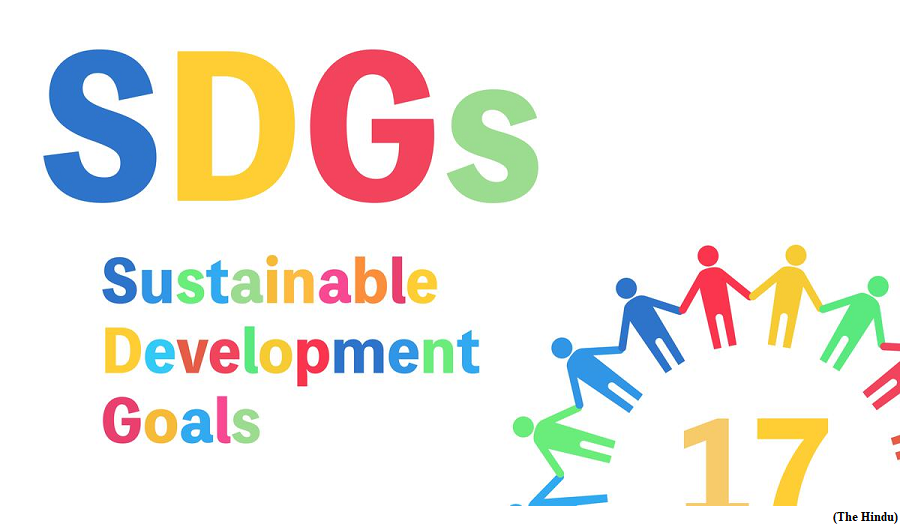Tracking SDG progress the Bhopal way (GS Paper 3, Economy)

Context:
- Bhopal has become the first city in India to join the growing global movement on localisation of Sustainable Development Goals (SDGs) following the release of its Voluntary Local Review (VLR).
Voluntary National Review (VNR):
- In 2015, the 193 member-states of the United Nations adopted the 2030 Agenda for Sustainable Development, which consists of 17 Sustainable Development Goals and 169 targets as a plan of action for ‘people’, ‘the planet’, and ‘prosperity’.
- The resolution specifies mechanisms for the monitoring, review, and reporting of progress as a measure of accountability towards the people.
- To this end, member-states submit a Voluntary National Review (VNR) to the UN’s High Level Political Forum (HLPF), and, more recently, VLRs as a means for driving and reporting local implementation of SDGs at the sub-national and city levels.
India’s progress:
- India has made commendable efforts towards the adoption, localisation, and achievement of the SDGs. NITI Aayog presented India’s second VNR at the HLPF convened in 2020.
- India’s Ministry of Statistics and Program Implementation (MoSPI) has published a National Indicator Framework (NIF) for the review and monitoring of the SDGs, which contextualises the UN’s Global Indicator Framework to represent India’s unique development journey.
- At least 23 States and Union Territories have prepared a vision document based on SDGs. Almost all of them have initiated steps to localise the SDGs. However, it has taken a while to get to India’s first Voluntary Local Review at the city level since the efforts to localise the SDGs began.
Cities as stakeholders:
- Cities are the most important stakeholders in Agenda 2030 as at least 65% of the 169 targets could not possibly be achieved without the engagement of local urban stakeholders.
- A VLR is a tool to demonstrate how local actions are leading the way in equitable and sustainable transformations for people and building a coalition of partners towards this endeavour.
- While it is desirable to align a city’s VLR to the State-level action plan (where available) and the country’s VNR, the process allows a great deal of flexibility to the cities to tell their story within a framework of their choice.
- The cities could choose their priority for the VLR process, articulating it either in terms of a quantitative assessment using various city level indicators relevant to the SDG targets or a narrative that describes the efforts and vision of the city.
Case of India:
- It may seem like a daunting task for Indian cities, particularly the non-metro urban local bodies, with limited capacity, resources, and disaggregated data to do a comprehensive VLR covering all SDGs.
- Therefore, a VLR does not have to be exhaustive in quantifying each of the 286 indicators under India’s NIF, which translate the global targets under the 17 SDGs into local indicators at the national level.
- Cities may choose specific SDGs for a detailed review as per their priority and logistical comfort. While doing so, they may adapt and further localise the national indicators under the relevant SDGs to reflect the city level realities.
- Globally, many cities choose to align their review with the SDGs that are taken up for detailed review by the HLPF in its ongoing cycle.
The Bhopal plan:
- Bhopal’s VLR is the result of a collaboration between the Bhopal Municipal Corporation, UN-Habitat, and a collective of over 23 local stakeholders.
- It has mapped 56 developmental projects to the SDGs across the three pillars, of ‘people’ (SDGs 1,3,4,5), ‘planet’ (SDGs 6,13,15) and ‘prosperity’ (SDGs 7,8,11).
- The objectives of building basic infrastructure and resilience emerge as a priority for the city from the number of projects mapped to the SDGs.
- The in-depth quantitative assessment of city-level indicators under SDG 11 (Sustainable cities and communities) records Bhopal’s stellar performance in solid waste management practices, public transportation, and open spaces per capita.
- However, the analysis also points to areas where the city needs to work much harder in the coming years to close the distance from the goals: provisioning of adequate shelter, high levels of air pollution, city planning capacity, and even distribution and accessibility of open spaces.
Global scenario:
- It represents people’s process, and any city-level stakeholder may take the initiative as long as the VLR is done within the overarching framework of Agenda 2030.
- A case in point is the city of Canterbury in the United Kingdom where some residents and local groups came together to form a “spontaneous coalition” that did the VLR.
- This coalition petitioned the local governments to work with city-level groups to advance the SDGs, and the latter merely served as an interlocutor in the VLR process.
- In the global South, there are examples of local governments in Dhulikhel (Nepal), Singra (Bangladesh), and Amman (Jordan) that worked in a similar context as that of Indian cities to publish their VLRs in 2022.
Way Forward:
- It is a remarkable opportunity for Indian cities to tell their stories in their own vocabulary, using a framework of their choice to forefront their work at a global platform.
- It is hoped that more Indian cities will follow Bhopal’s lead, to showcase urban innovations and collaborations emerging from India on the global map.


